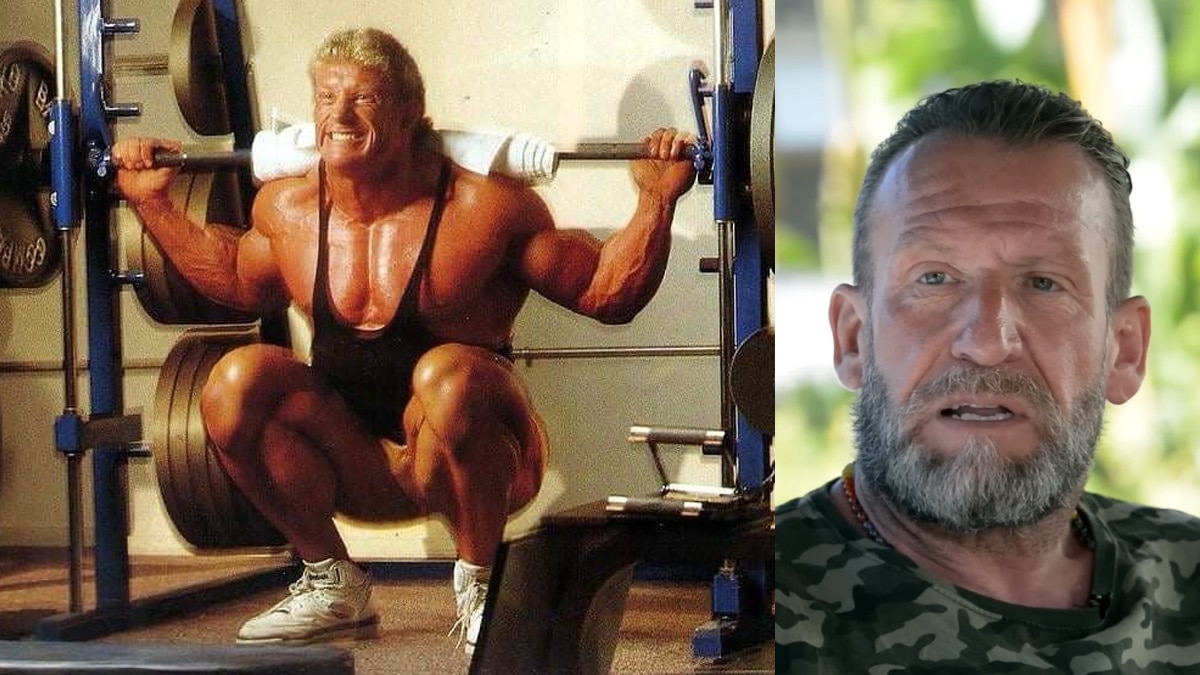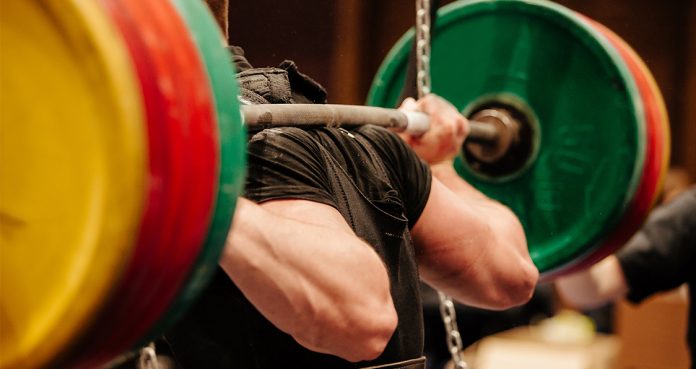Tag: front squats

Dorian Yates Explains Why ‘You Don’t Need To Do Squats’ & Training 4x a Week for Mr. Olympia
Bodybuilding legend Dorian Yates stood out from the pack during his days of professional competition with his intense training methods. The English talent led one of the most successful careers in the IFBB Pro League by going against the grain when it comes to training philosophy. In a recent interview with Escaped Fitness, Yates explained why there is no need to do squats for muscle growth and opened up on training four days a week for the Mr. Olympia competitions.
Dorian Yates rose to prominence for his shocking muscularity, size, and stellar conditioning as a Men’s Open contender. He presented arguably the best back muscle development of any competitor in the history of the sport. After taking silver in his Olympia debut, Yates secured his maiden Sandow trophy in 1992. He proved to be a dominant champion who racked up a total of six Mr. Olympia wins until 1997.
Yates was renowned for staying away from the spotlight in the off-season and only making his presence known for competition. His tendency to stay on the sidelines and avoid media attention earned him the nickname ‘The Shadow.’ While most bodybuilders used the traditional approach of working for a fixed number of sets and reps, Yates focused on pushing himself to near failure in every single training session.
In Nov. 2022, Yates reflected on the beginnings of his bodybuilding journey as a troubled teenager in prison. He opened up on the intense mindset he adopted in which he was completely obsessed with bodybuilding. He credited the sport for helping him turn his life around at a crucial point.
Bodybuilding veteran Rich Gaspari compared the backs of Yates and reigning Mr. Olympia Hadi Choopan to criticize ‘The Persian Wolf’ last December. He used the comparison to prove that conditioning levels had dropped significantly from era to era.
Dorian Yates maintains a high level of personal fitness. He reported excellent findings after undergoing a health check and VO2 max test earlier this year. Despite being in his 60s, his biological age was estimated to be between 30 and 39.
‘The Shadow’ offered barbell rows with an underhand grip as his favorite exercise for building a jacked back two months ago. Then, he stressed the importance of keeping proper nutrition and rest for optimizing hormone balance.
In another offering to fans, Yates provided a few of his high-intensity training techniques to increase the difficulty of workouts. His next update encouraged his fans to focus on completing a full range of motion and using slow negatives to boost muscle growth in the lower body.
Related: Ten Ways to Boost Your Squat
Dorian Yates Explains Why ‘You Don’t Need to do Squats’
In a recent YouTube video, Dorian Yates shared why it is not necessary to include squats in your training plan.
“I always ask why. That’s a big thing with me,” said Yates. “Squats are the best things for legs everyone says. Why? Alright let me try to do something else. I did believe that until squats damaged my hip so I had to try and do something else and I discovered you can do it another way. You don’t need to do squats. Everybody was training six days a week and 20 sets and all this stuff from the Arnold era and didn’t make sense to me.”
Yates revealed he follows the teachings of Arthur Jones, founder of Nautilus when it comes to training frequency and achieving muscle growth.
“I read Arthur Jones’s writings, who’s the guy that built the Nautilus machines and looked into the real science of muscle building and so on and Mike Mentzer of course carried on that high intensity training. So, it made logical sense to me. Then when I applied it in the gym, keeping notes and so on, I got very good feedback from day one. I noticed that if I train more often or increase the volume and time in the gym, I stopped progressing. Okay, let me take a couple of days rest and go back to a more abbreviated routine, train three days a week, no more than an hour, boom, start growing again. There’s the feedback.”
Yates used to train 4 days a week for Mr. Olympia
’The Shadow’ revealed he only trained four days a week with a maximum of one hour per session for the Mr. Olympia contests.
“Three days a week I was training initially when I first started training because I was working a job as well and couldn’t recover training more often than that. That’s what the feedback showed me so I listened to it. Later on, training for Mr. Olympia, I was training four days a week and maximum one hour in the gym.”
“People struggle with that because they don’t understand the key. The key to stimulating muscle growth is the intensity of the exercise and the fact that you’re progressively overloading and giving your body something that it’s not used to and it needs to react. Muscle Growth is just a reaction to a stress that the body’s trying to protect itself from.”
The 61-year-old laid out a straightforward approach for building muscle with efficient training and recovery.
“This is the process, stimulate, overload, recovery, after recovery, overcompensation, growth, so if that recovery or stimulus period isn’t sufficient, you’re not going to grow. There needs to be a balance between all that. Intensity and recovery. So if you’re going in there hammering your legs. You’re breaking them down and damaging them and they’re sore, and then four days later you train them again and still sore, damaged, how are you getting anywhere? You’re not really getting anywhere.”
Dorian Yates offered the training and steroid cycles he utilized while preparing for contests in his heyday. He also opened up on his reasons for using TRT (testosterone replacement therapy) after retiring from the sport. As of late, Yates described his experience using ayahuasca in the Amazon rainforest, which he says helped him achieve a new level of mental clarity.
Yates’ latest offering goes against the common belief that squats are a must in any training plan for muscle growth. Given his experience and accolades, Yates continues to be a service to the bodybuilding community.
You can watch the full video below:
RELATED: 6x Mr. Olympia Dorian Yates Guides Junior Mr. Universe Kaya Yusuf Through Brutal Back Workout
Published: 28 May, 2023 | 1:27 PM EDT

Front Squat Without Wrist Pain Or The Risk Of The Barbell Sliding
Vital Front Squat Grip Variations
The traditional back squats work your quads, hamstrings, and glutes while the front squats primarily target your quads. The front squats can be harder to perform as compared to the back squats. The front squats can put a lot of pressure on your lower back, wrists, and forearms.
If this wasn’t enough, there is always the possibility of the bar sliding forward while you perform a front squat. There are two variations of the front squat which can put varying degrees of pressure on your wrists and forearms.
The Weightlifter Grip
The weightlifter grip is also known as the full grip. A full grip involves holding the barbell with an overhand grip right outside shoulder-width. You need to keep your elbows pointed up so your upper arms are at least parallel to the floor.
The weightlifter’s grip requires mobility in your wrists, forearms, shoulders and lower back, and is the harder of the two variations to perform. The full grip can help you keep the weights pinned to your shoulders so you can lift heavier weights.
The Bodybuilder Grip
The bodybuilder front squat grip involves holding the barbell with a crossed-arm grip. The crossed-arm grip is used by people who have limited mobility in their wrists and forearms. You can only hold the barbell in place with the bodybuilder front squat grip.
You can’t actively push the bar into your shoulders while you perform a front squat with this grip. It is even more important to keep your elbows pointed up with the bodybuilder’s grip as the chances of the bar sliding forward are significantly higher.
Get Rid of Wrist Pain During Front Squats
If you use the weightlifter’s grip, you can encounter wrist and forearm pain while performing the squats. You will be in a better position if you perform a couple of warmup exercises and stretches for your wrists before going into the squats.
Extended Arm Wrist Stretches
The extended arm wrist stretches are the simplest warmups for the front squats. Extend your right arm with your palm facing the ceiling. Gently pull the fingers of your right arm towards your body with your left hand. Hold the stretch for 10-30 seconds.
Repeat the process with your left arm as the base arm. After you’re done with two sets of this exercise, point your palm towards the floor and repeat the stretching exercise. Doing this will warm up your upper and lower forearms.
Open Chest Stretches
The open chest stretching will help get your shoulders, chest, and wrists get warmed up for the front squats. Stand beside a squat rack with your arm extended and keep your elbow locked out.
Place your fingers on the squat rack and slowly start rotating away from the squat rack. After you’re done with the extended arm and open chest stretch, you’ll feel improved mobility in your wrists, forearms, and shoulders.
Avoid the Risk of the Bar Sliding Forward During Front Squats
Most people avoid performing the front squats because they can’t keep the bar steady on their shoulders. The bar sliding problem persists with both the weightlifter and bodybuilder grips. Before placing the bar on your shoulders, push your shoulders and arms forward so the bar can rest in the hole formed in the shoulder joints.
The best way to get rid of the bar sliding problem is to actively push your elbows upwards while you’re performing a front squat. Doing this will also help you keep your back straight which will put more tension on your quads.
At any point during the front squats, your elbows should not go below parallel to the floor. Looking at the roof while performing the squats can help you in keeping your elbows pointed up and your back straight.
Which grip do you use while front squatting? Let us know in the comments below. Also, be sure to follow Generation Iron on Facebook and Twitter.
*Header image courtesy of Envato Elements.
